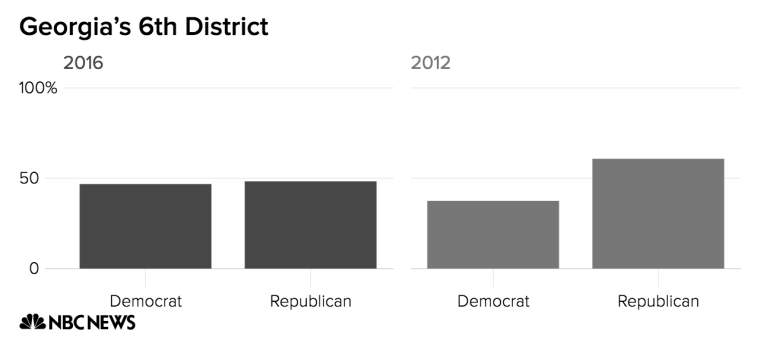In the next few months, Georgia and Montana will hold special elections to fill newly vacant House seats, and what happens in those races may tell us a lot about the broader state of the Democratic and Republican parties in the distant 2018 midterms.
The two districts in question, an at-large seat in Montana and one in Georgia’s 6th, will test two big questions coming out of 2016: Do the Democrats have any hope of making a dent with the white rural voters who helped tipped the scales for President Donald Trump in November? And are Republicans in danger of losing their hold in diverse, well-educated urban places where Hillary Clinton did very well and made gains?
The two districts could not be more different.
Will Trump Shake Supporters Loose in Montana?
Montana’s district — there’s only one in the state — sprawls over 145,000 miles with just more than 7 people per square mile. It is also 87 percent white and non-Hispanic, compared to the national figure of 62 percent. The district is also older, with 44 percent of the population age 45 or older, compared to the national figure of 40 percent.
The 2016 exit poll numbers suggest those demographics should bode well for Montana Republicans in the Trump era. Rural, white and older voters were a lynchpin of his White House win.

Republican Ryan Zinke won the seat in November by some 16 points before being selected as Trump’s Secretary of the Interior.
History seems to be on the GOP’s side, as well. Montana’s congressional seat has been in Republican hands since 1997 and four different Republicans have held it, so it’s not just about one very popular legislator.
What could be different this time?
President Trump is one big answer. The first few weeks of the Trump White House have been turbulent and, if the bumps continue, they could start shaking supporters off the Trump Train — even in Montana.
In addition, Democrats have done well in Montana’s statewide elections. They hold the governor’s mansion and one of the two Senate seats. In 2016, Democratic Gov. Steve Bullock won reelection by 4 points, even as Trump won the presidential vote in Montana by more than 20 points. In other words, voters in Montana are not obsessed with the party of their politicians.
If the Democrats find the right candidate and the Trump White House continues to struggle, the party may be able to make the congressional race competitive or, possibly, even flip the seat blue. It may be a long shot, but those results would give the Democrats some kind of hope in the dozens of rural House districts up in the 2018 midterm elections.
A Potential Minefield in Georgia
Georgia’s 6th has also been solidly Republican, historically. It’s been in GOP hands since 1979, when former Rep. Newt Gingrich won it — though it has been through several redistricts since then. In November, incumbent Republican Tom Price won the seat by roughly 23 points before being selected as Trump’s Secretary of Health and Human Services.
But the similarities stop there.
Georgia’s 6th District runs through many of the northern suburbs of Atlanta and it holds more than 2,400 people per square mile. It is far more diverse than Montana with a white, non-Hispanic population that sits just under 62 percent. It is also very wealthy — median household income is more than $83,000 — and very well educated, with 60 percent of the 25-and-older population holding at least a bachelor’s degree.
It is the kind of dense urban suburb environment where Hillary Clinton did well in 2016. And, indeed, Clinton did much better in Georgia’s 6th District (R +1.5 points) than Barack Obama did in 2012 (R +23.3 points), according to a district-level analysis of the presidential vote.

That’s a massive swing and it likely has more to do with voters not warming to Trump than to a sudden change in political views. Data from the latest NBC News/Wall Street Journal poll show how the 6th is a potential minefield for supporters of the president.
Among those making $75,000 or more, 50 percent disapprove of Trump’s job performance. Among college graduates his disapproval number is 60 percent. And among minority voters, his disapproval number is 65 percent. That’s a lot of red flags for whoever wins the GOP nomination in the 6th.
It may be that the Trump Republican Party is a poor fit for the district in a general election. At the very least, the eventual Republican nominee is going to have to figure out how to deal with the inevitable Trump questions he or she will face in the campaign.
If the special election is close, or if the Democrats win the race, it could be a sign that similar districts are targets of opportunity for the party when the midterm elections come — and Republicans will have a sense of how vulnerable those places may be.
Of course, the Montana and Georgia races are just two House seats. And in each, there will be other important contributing factors — candidates and individual issue environments still matter. But these two states offer an early look at challenges and opportunities both parties will face on the 2018 battlefield.